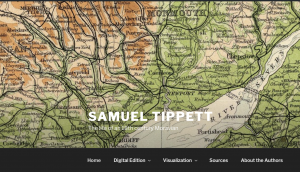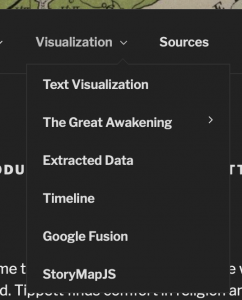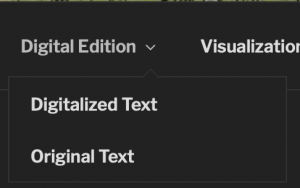http://tippetthumn100.blogs.bucknell.edu
All the work my group has done this year was in hopes of answering the question, “How did religion give Samuel Tippett and others during this time a new life?” This Final Project allowed my group to take every tool that we have learned this semester and put it on display, and it provided us with the opportunity to answer our research question with a multitude of data and representations. We started this semester with a simple task of transcription, and that first step, which at the time seemed tedious, produced the framework for me to explore completely new ways of analyzing literature. From the beginning of my schooling experience until the start of this year, I believed that there was only one way to approach literature. My whole life I have read material and formulate an argument via essays. These essays that I wrote in high school and middle school were completely structured and did not allow for much creativity. We had the simple guideline of an introduction followed by three body paragraphs and then a conclusion. I spent six years of my life writing essays the exact same way. This changed a little when I came to college, but that change really only came in being able to use more than three body paragraphs (not extremely exciting!). This class has provided me with a completely different way of creating and presenting an argument and this final project shows an accumulation of all new ways my team and I have been able to analyze our Memoir and answer our research question.
Our Website has two main components to it. We have separated our material into categories of Digital Edition and Visualization. Under Digital Edition we provide the viewer with an opportunity to see the original copy of Samuel Tippett’s memoir along with the digital edition we, as a group, created. We made the conscious decision to not include our work from Oxygen and Github because we believed that someone who does not understand how that software works would have a hard time understanding what it actually showed. We did use the data given to us from those websites and the activity of tagging in two of the visualization tools, “Google Fusion” and “Extracted Data”. Under the Visualization tab there are six different options to be clicked on. They are: Voyant, Important People, Important Places, Timeline, Google Fusion, and Story Map. All of these tools are used to analyze the same memoir, but they focus on different aspects of the text, or they focus on the same aspect of the text but provide a different analysis.
After we finished our transcription we were able to upload our transcription into a website that reads, analyzes, and produces creative visual representations of the data and patterns that summarize the texts. The most helpful tool that Voyant produced for me was the word cloud. Our word cloud showed me that the words used most frequently in Tippett’s memoir were “Heart”, “Lord”, and “Savior”. Based off of this word cloud without even reading the Memoir one would be able to see that religion played a major role in Tippett’s life, and as we moved forward in our analysis it became clearer and clearer that it indeed did.
The creation of our Timeline provided our group with a visual construction of Tippett’s life in a linear fashion. We understood that chronology is an important discipline in learning how to interpret the past. Before creating this timeline I was under the impression that timelines really only offered a list of facts that occured in chronological order with very little connection. After creating this timeline I had a completely different understanding of how timelines can be interpreted and how time itself works. I realized that timelines can offer a much more in depth analysis of data than I had previously believed possible. The Indian historian Romila Thapar, “long emphasized that genealogy and chronicle are not primitive efforts to write what would become history in other hands, but powerful, graphically dense ways of describing and interpreting the past.” (TIP-13)
After we finished our timelines we worked on creating Google Fusion tables. This exercise allowed us to generate visible relationships between two different entities. We chose to look at the relationship between Person Name and Place Name. Through this activity we were able to see that every person that Tippett mentions throughout his memoir has a connection to religion, further supporting the idea that religion played a role a major role in many people’s lives throughout this time period. Some important people mentioned were Brothers Cennick, Whitefield, and Wesley. Cennick, much like Tippett, was a misbehaved child who found a passion for religion later in life. Cennick witnessed his aunt, on her deathbed, completely at peace because of her relationship to the Lord. Cennick explans, “The words she uttered indeed pierced my soul, so that I could not rest day nor night, but wishing continually after, if I thought of death and sickness, O that I may be assured of heaven before I die!” (JStor-36) Wesley and Whitefield had a more traditional connection to religion. Religion played a major role in both of their early lives and then they both preceded to attend Oxford University where they discovered their passion for preaching. Both individuals were famous for the ability to connect with their audiences, and many even see Wesley as, “the founder of the methodist movement.” (UMC.org)
The final tool we learned to use the StoryMapJS. At first glance it may seem like StoryMapJS is simply a more complicated timeline, but it actually provides a platform to creatively use space as a way of presenting data. Bodenhamer explains, “We are drawn to issues of meaning, and space offers a way to understand fundamentally how we order our world” (14). In the context of our website, the spaces that we are trying to draw meaning to are cities and villages within the UK. Tippett began his life as a careless troublemaker, but as he grew older and older his perception of the world changed and he dedicated himself to Jesus and began a never ending journey of achieving Jesus’ forgiveness. The StoryMap tracks Tippett travels throughout this Journey.
Looking at the data that we compiled this semester, our group believes that we have proved religion did give Samuel Tippett a new life and most likely provided a similar experience for many other people. Through Voyant we were able to capture a glimpse of how religion centered Tippett’s memoir. The timeline provided us with evidence that every event important enough to be dated was related to religion. Finally both Google Fusion and StoryMapJS allowed us to see that anytime that Tippett changed locations it was with intentions to become more and more religious. Tippett’s life was dominated by religion during a time period coined “The Great Awakening”, so it is not outlandish to believe that many other people had similar experiences. My group looks forward for viewers of our website to make their own conclusions.



Clayton Wright is an economics major at Bucknell University. He transferred to Bucknell from Bowdoin College in 2017. Before college, he grew up in Summit NJ and attended The Pingry School.



